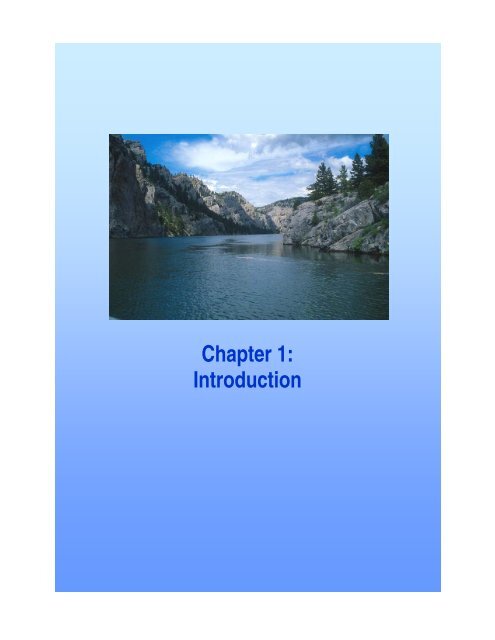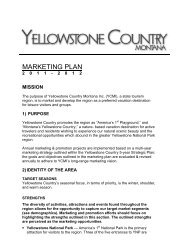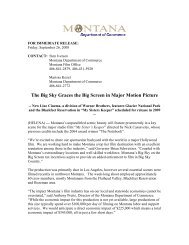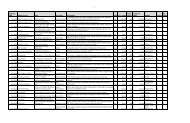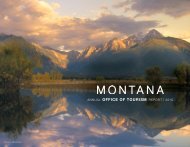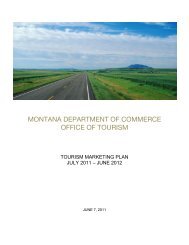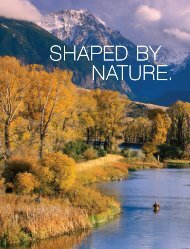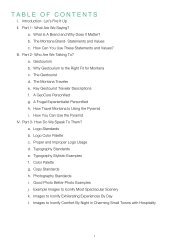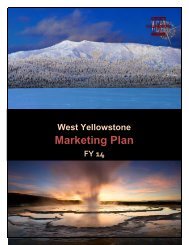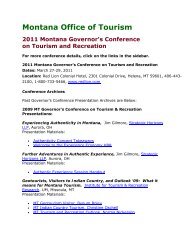Chapter 1: Introduction - Montana Office of Tourism
Chapter 1: Introduction - Montana Office of Tourism
Chapter 1: Introduction - Montana Office of Tourism
Create successful ePaper yourself
Turn your PDF publications into a flip-book with our unique Google optimized e-Paper software.
<strong>Chapter</strong> 1:<strong>Introduction</strong>
Strategic Plan AssumptionsThis <strong>Tourism</strong> and Recreation Strategic Plan was developed using thefollowing assumptions, which provided context to the discussions:‣ Natural, cultural, and historic resources must be protected andmaintained in order for tourism to be sustainable long-term.‣ State, federal, and tribal land management agencies areessential partners in tourism success.‣ <strong>Montana</strong> residents understand that nonresident travelers helptheir economy (with some trade<strong>of</strong>fs, such as sharing theirrestaurants, highways, parks, ski areas, and public lands withvisitors).‣ <strong>Montana</strong>ns generally support increased tourism, with some limitsand controls.‣ <strong>Tourism</strong> and recreation-oriented facilities and experiencesimprove the quality <strong>of</strong> life for <strong>Montana</strong>ns.‣ <strong>Tourism</strong> facilities and services in <strong>Montana</strong> are significantly underutilizedmost <strong>of</strong> the year (with the exception <strong>of</strong> peak season).‣ Highly targeted and effective marketing efforts are needed tocounter increasing competition from national and global tourismdestinations.‣ Targeting “high value - low impact” travelers is desirable (seedefinition below).‣ Good data and information, available in a timely and useablemanner, is essential for strategic tourism industry decisionmaking.DefinitionsTraveler: Data reported in this Strategic Plan are consistent with the <strong>Tourism</strong> Industry Association (TIA) and University <strong>of</strong><strong>Montana</strong> Institute for <strong>Tourism</strong> & Recreation Research (ITRR) definitions <strong>of</strong> a traveler, which is someone who travels more than50 miles from home one-way, or spends one or more nights away from home, whether a resident or nonresident. Nonresidenttravelers are defined by ITRR as those who enter <strong>Montana</strong> by private vehicle or commercial air carrier, and whose primaryresidence is not <strong>Montana</strong>.Recreation: In the context <strong>of</strong> this Strategic Plan, recreation refers to active leisure activities in which <strong>Montana</strong>ns andnonresident visitors participate while they are travelers.<strong>Tourism</strong> Industry: The term “tourism industry” refers to all private, public, nonpr<strong>of</strong>it, and tribal organizations involved in tourismand recreation in <strong>Montana</strong>, including local, state, federal, and tribal agencies.High-Value, Low-Impact Visitor: A visitor who contributes to <strong>Montana</strong>’s economic and social prosperity while respectingand appreciating <strong>Montana</strong>’s authentic natural and cultural assets.<strong>Montana</strong> <strong>Tourism</strong> Seasons: This Strategic Plan uses seasonal designations consistent with those used by ITRR and the<strong>Montana</strong> Department <strong>of</strong> Revenue (DOR), which are based on calendar year quarters, as follows:Peak Season: 3 rd quarter (July-September).Note that, in reality, peak tourist season also includes June, as defined by statewide hotel occupancy rates <strong>of</strong> 76% to85% from June through September, according to Smith Travel Research (2007).Off-Peak Seasons: 1 st quarter (January-March), 2 nd quarter (April-June), 4 th quarter (October-December).Note that the statewide hotel occupancy rate is about 39% in December and January, 46%-52% in February, March,April and November, and about 60% in May and October, according to Smith Travel Research.2 <strong>Chapter</strong> 1: <strong>Introduction</strong> <strong>Montana</strong> <strong>Tourism</strong> and Recreation Strategic Plan 2008-2012
Strategic Plan Purpose and ProcessStrategic Plan Specifies Actions for Sustainable <strong>Tourism</strong>This <strong>Tourism</strong> and Recreation Strategic Plan provides the road map to strategic andsustainable tourism development in <strong>Montana</strong> from 2008 to 2012, and goes wellbeyond tourism promotion by addressing resource management, workforcedevelopment, affordable housing, transportation, and tourism-related communityenhancement issues. The Strategic Plan:♦ Serves as a blueprint for a strategic, integrated approach to tourism andrecreation development and marketing in <strong>Montana</strong>.♦ Confirms priorities to focus resources.♦ Balances <strong>Montana</strong>’s tourism promotion efforts, products, and partnerships.♦ Assigns responsibilities for implementation.♦ Identifies funding sources to pay for actions.♦ Measures results and return on investment.Nonresident Travelers Bring $3 Billion Annually to <strong>Montana</strong>Nonresident traveler spending contributes nearly $3 billion to <strong>Montana</strong>’s economy, <strong>of</strong>which $300+ million is lodging sales that generates more than $12 million in lodgingfacility use taxes (4%) and more than $9 million in select sales accommodations taxes(3%). Total nonresident tourism expenditures doubled from 1995 to 2005 ($1.36 billionto $2.76 billion), and the industry continues to grow at a healthy pace. These revenuessupport facilities and services that improve the quality <strong>of</strong> life in <strong>Montana</strong>.<strong>Tourism</strong> Supports <strong>Montana</strong>’s Other Economic Development EffortsIn most communities, 75% <strong>of</strong> the businesses depend on wealth attracted from outsidethe community by the 25% <strong>of</strong> businesses with national and global markets – includingtourism businesses. <strong>Tourism</strong> is an essential component <strong>of</strong> <strong>Montana</strong>’s economy:tourism attracts new revenues and business investment by promoting a positive image<strong>of</strong> the state, showcasing its quality <strong>of</strong> life and people, and generating increased visitorspending. <strong>Tourism</strong> benefits <strong>Montana</strong> communities, and it also provides a means forsocial exchanges between <strong>Montana</strong>ns and visitors from around the world.<strong>Tourism</strong> Seasonality Results in 4.6 Million Vacant Room NightsNearly half <strong>of</strong> all lodging sales in <strong>Montana</strong> occur in the third quarter (July-September),and two-thirds occur in the second and third quarters combined (see figure at right).Therefore, most <strong>Montana</strong> hotels and other tourism facilities are underutilized much <strong>of</strong>the year. There were more than 4.6 million vacant hotel room nights in 2006,particularly in November through April, based on a statewide year-round hoteloccupancy rate <strong>of</strong> 59.5% (the national average was 64%). 1 If filled, those vacant hotelrooms would have generated $309 million in revenue, and $21.7 million in lodgingtaxes, based on the 2006 average room rate in <strong>Montana</strong> <strong>of</strong> $67.73 per night (thenational average was $95.64). The underutilization creates instability in tourismindustry revenues and jobs, and affects other sectors <strong>of</strong> <strong>Montana</strong>’s economy.In 2006, there were more than 4.6 million vacant hotel room nights in <strong>Montana</strong>. If filled,those rooms would have generated $309 million in revenue, and $21.7 million in lodgingtaxes. Growth in <strong>of</strong>f-peak season tourism would help address underutilization.1 Smith Travel Report, 20062006 <strong>Montana</strong> <strong>Tourism</strong>Fast FactsNonresident visitors: 10.4 millionExpenditures: $2.9 billionSeasonality: 70% visit Apr-Sept30% visit Oct-MarReason for Trip: 34% Vacation27% Passing Through19% Visiting Friends & Family13% Business, 8% ShoppingOrigin: 12% WA, 10% ID, 8% WY,7% CA, 5% ND/UT, 4% CO/MN,8% Canada, 2% OverseasTravel Party Composition:32% couples28% family/extended family27% traveling aloneActivities While in <strong>Montana</strong>:45% Driving for Pleasure32% Wildlife Watching26% Recreational Shopping:23% Day Hiking20% Picnicking19% Visiting Historic Sites14% ea. L&C Sites, Museums:11% Fishing/Nature Study10% Native American Sites10% Camping (developed)8% Festivals or Events6% Gambling5% ea. Dnhll Skiing, Birding,Rafting, Horse Riding4% ea. Golf, Art Exhibits3% ea. Biking, ATVing,Backpacking, Paddling,Hunting, Sports EventSource: ITRR2006 Lodging Facility Use TaxCollections by QuarterSource: MT Dept. <strong>of</strong> Rev enueQ2$3,756,35123%Q1$2,790,58317%Q3$6,848,67543%Q4$2,700,56717%<strong>Montana</strong> <strong>Tourism</strong> and Recreation Strategic Plan 2008-2012 <strong>Chapter</strong> 1: <strong>Introduction</strong> 3
More than 1,200 <strong>Montana</strong>ns Participated in the Planning ProcessThe development <strong>of</strong> this Strategic Plan began in October 2006, and was completed inNovember 2007. The process included extensive outreach and input from tourism andrecreation businesses, public agencies, tribes, arts and historical organizations,farmers and ranchers, conservation groups, motorized recreation enthusiasts,sportsmen, and other interested members <strong>of</strong> the public. Through public meetings,interviews, a statewide survey, and the Governor’s Conference on <strong>Tourism</strong>, more than1,200 <strong>Montana</strong> citizens, businesses, and organization representatives provided input.The process included four phases:1. Information-gathering (October 2006 – March 2007)2. Refinement <strong>of</strong> strategies and actions (February – April 2007)3. Draft Strategic Plan for public and stakeholder comment (May – Oct. 2007)4. Completion <strong>of</strong> final Strategic Plan document (Oct. – December 2007)“Economic Development”is happening when:♦ The standard <strong>of</strong> living isincreasing.♦ A “real” increase in the level<strong>of</strong> average householdincome is occurring.♦ The local tax base ismeeting the escalating cost<strong>of</strong> government services.♦ Business and industry areinvesting more in thecommunity than they are“costing” the community.As with all forms <strong>of</strong> economicdevelopment, the process <strong>of</strong>tourism development isfacilitated through:♦ Development <strong>of</strong> a skilledworkforce.♦ Investment in physicalinfrastructure.♦ Creation <strong>of</strong> new jobs athigher wages.♦ Improvement <strong>of</strong> thebusiness environment.♦ Availability <strong>of</strong> marketableland and buildings.♦ Protection <strong>of</strong> theenvironment.♦ Improvement <strong>of</strong> the quality<strong>of</strong> life.♦ Effective marketing andpromotion.Source: Dr. David Kolzow,Strategic Planning for EconomicDevelopmentStrategic Plan Addresses all Facets <strong>of</strong> <strong>Tourism</strong> and Recreation in<strong>Montana</strong>, including Links to Economic and Community Development,Resource Management, Conservation, and Public PolicyThis Strategic Plan is designed to be used by all organizations in <strong>Montana</strong>’s tourismand recreation industry – private, public, tribal, and nonpr<strong>of</strong>it. In other words, it is not“Travel <strong>Montana</strong>’s Plan”, nor is it a plan just for regional tourism organizations,convention and visitor bureaus, lodging properties, ski resorts, etc. Rather, it is a planthat integrates tourism and recreation into <strong>Montana</strong>’s economic and communitydevelopment, resource management, and public policy efforts. It <strong>of</strong>fers a holistic view<strong>of</strong> tourism and recreation planning and implementation, addressing not onlypromotion, but also the product itself, and the partnerships required for successfulimplementation. The figure below summarizes the areas <strong>of</strong> responsibility for<strong>Montana</strong>’s tourism and recreation partners. More detail is provided on the next page.<strong>Tourism</strong> Strategic Plan Partnersand Their Areas <strong>of</strong> ResponsibilityPromotionTravel <strong>Montana</strong>Regions, CVBsChamber, VICsTribes/MTTABusinessesAssetVisitorPublishersManagementMediaServicesProperty OwnersMTRI, NPS, USFSFWS, BLM, USACEBOR, BIA, TribesPartnershipsLodging, Dining, RetailAttractions, OutfittersTransportation, ParksFarming, RanchingFWP, DNRCPublic-Private-VICs, ChambersMHS, MHCTribal-Nonpr<strong>of</strong>it Org’sMDT, MACNonpr<strong>of</strong>itWholesalersEducationInvestorsPolicyGovernor/Cabinet<strong>Montana</strong> Legislature<strong>Tourism</strong> Advisory CouncilState CommissionsState AgenciesU.S. CongressFederal AgenciesTribal GovernmentLocal GovernmentResources<strong>Tourism</strong> Advisory Council<strong>Montana</strong> LegislatureUniversities/Colleges<strong>Montana</strong> SuperhostState AgenciesFederal AgenciesMT Main StreetTrade Assn’sFoundations4 <strong>Chapter</strong> 1: <strong>Introduction</strong> <strong>Montana</strong> <strong>Tourism</strong> and Recreation Strategic Plan 2008-2012
<strong>Tourism</strong> Partners and Their RolesSuccessful <strong>Tourism</strong> Requires Strong Partnerships<strong>Tourism</strong> is a diverse industry that involves lodging and dining facilities, retail stores,transportation services, outfitters and guides, entertainment, public lands and wildlife,historic and cultural attractions, agriculture, ranching, wholesale suppliers, insuranceand financial services, workforce and education services, media and publishing,architecture and construction, etc. In many <strong>Montana</strong> communities, some <strong>of</strong> theseservices would not exist without the revenue that tourism provides to support them. Inorder to maintain a successful tourism industry, these partners must understand eachother’s roles, and work together toward a common vision.The Partners figure on page 4 lists the key partners involved in the <strong>Tourism</strong> andRecreation Strategic Plan implementation, and how their roles relate to each other:♦ Policy-makers provide direction and authorization for activities to happen.♦ Asset managers build, maintain, and/or protect <strong>Montana</strong>’s natural, cultural, tribal,and historic assets.♦ Visitor services provide products and services needed by visitors to enjoy avacation experience.♦ Funding entities provide the resources to implement strategic actions.♦ And finally, promotion partners communicate tourism and recreation opportunitiesto targeted high value, low impact visitor niche markets.The <strong>Montana</strong> partners that fulfill these roles are shown in the figure on page 4, andlisted below. As the figure shows, the focal point <strong>of</strong> success is partnerships to achievethe plan’s goals. Each <strong>of</strong> the partners plays a critical role in managing and enhancingtourism and recreation in <strong>Montana</strong>:♦ <strong>Tourism</strong> businesses and industry associations: private businesses andcorporations, Travel Industry Assn. <strong>of</strong> <strong>Montana</strong> (TIAM), <strong>Montana</strong> Ski Areas Assn.(MSAA), <strong>Montana</strong> Innkeepers Assn. (MIKA), <strong>Montana</strong> Outfitters & Guides Assn.(MOGA), Fishing Outfitters Assn. <strong>of</strong> <strong>Montana</strong> (FOAM), <strong>Montana</strong> EconomicDevelopers Assn. (MEDA), <strong>Montana</strong> Dude Rancher’s Assn. (MTDRA), etc.♦ Elected and appointed <strong>of</strong>ficials: state, city, county, tribal, federal, <strong>Tourism</strong>Advisory Council (TAC), state commissions, etc.♦ State agencies: Department <strong>of</strong> Commerce Promotion Division (“Travel<strong>Montana</strong>”), Fish, Wildlife & Parks (FWP), Department <strong>of</strong> Transportation (MDT),Department <strong>of</strong> Natural Resources & Conservation (DNRC), Department <strong>of</strong>Revenue (DOR), <strong>Montana</strong> Historical Society (MHS), <strong>Montana</strong> Arts Council (MAC),<strong>Montana</strong> Heritage Commission (MHC), and universities and colleges.♦ <strong>Tourism</strong> regions (“countries”) and convention and visitor bureaus (CVBs)♦ Tribal organizations: <strong>Montana</strong> Tribal <strong>Tourism</strong> Alliance (MTTA), <strong>Montana</strong> IndianBusiness Alliance (MIBA), and <strong>Montana</strong> Tribes.♦ Federal agencies: National Park Service (NPS), U.S. Forest Service (USFS),U.S. Fish & Wildlife Service (FWS), Bureau <strong>of</strong> Land Management (BLM), U.S.Army Corps <strong>of</strong> Engineers (USACE), Bureau <strong>of</strong> Reclamation (BOR).♦ <strong>Montana</strong> <strong>Tourism</strong> & Recreation Initiative (MTRI): a chartered organization <strong>of</strong>state and federal agency staff and directors who work collaboratively on tourismand recreation initiatives involving public lands and waters.♦ State and local nonpr<strong>of</strong>it organizations: conservation, sportsmen, motorizedand nonmotorized recreation, arts, historical societies, economic development.<strong>Tourism</strong> and recreation growssuccessfully if strong publicprivate-tribalpartnerships arecreated and cultivated.<strong>Tourism</strong> Partner RolesAssetManagementPolicyPromotionPartnershipsResourcesVisitorServices<strong>Tourism</strong> Strategic PartnersEach <strong>of</strong> the partners plays anessential role in managing andenhancing tourism andrecreation in <strong>Montana</strong>.<strong>Montana</strong> <strong>Tourism</strong> and Recreation Strategic Plan 2008-2012 <strong>Chapter</strong> 1: <strong>Introduction</strong> 5
“<strong>Montana</strong>’s state tourismdepartment does a good job butthey need to continue to workwith our legislature to ensurereceipt <strong>of</strong> all possible funding tocontinue effectively market thisstate.”- Survey RespondentConsumer Marketing37.2%Telemarketing & Fulfillment11.1%Visitor Information Centers2.7%Travel <strong>Montana</strong> Provides LeadershipThe lead agency for tourism promotion and development in <strong>Montana</strong> is theDepartment <strong>of</strong> Commerce Promotion Division, or “Travel <strong>Montana</strong>.” Their activitiesinclude development <strong>of</strong> the state’s marketing brand and image; implementation <strong>of</strong> the<strong>Tourism</strong> Marketing Plan; management <strong>of</strong> tourism web sites, publications, anddatabases; analysis and dissemination <strong>of</strong> market research and tourism leads;communication and coordination with the tourism industry partners and elected<strong>of</strong>ficials; administration <strong>of</strong> tourism-related grant programs; recruitment <strong>of</strong> the filmindustry; and tracking <strong>of</strong> results and return on investment <strong>of</strong> marketing funds. Specificprograms are listed below, and funding allocations are shown in the figure below.Consumer Marketing: print/web/TV advertising, branding, target markets, MT Kids,3Parks, Sled the Rockies, ski campaign, Invite-A-Friend, research, co-ops, direct mail,eNewsletters, and partnerships for enhanced print, TV, web and event opportunities.Visitor Information Centers (VICs): coordination/oversight <strong>of</strong> nine gateway VICsoperated through state-community partnerships to provide information to visitors.Publicity/Photography: publicity campaigns, writer familiarization trips, co-ops withregions/CVBs, image library, electronic press room, in-state publicity, tourism education/outreach,Intranet content, e-newsletters, fire/crisis communication, fact sheets.Electronic Services: consumer web sites, Oracle ‘tourism’ database, Siebelsupport/VISITS, Real Simple Syndication (RSS), photo and story/testimonial sharing,eMarketing services, targeted linking, MT VICs technical support, partnerships withregions/CVBs/chambers on web features.General Administration Industry Services: <strong>Tourism</strong> Advisory Council (TAC) support,disbursement/oversight <strong>of</strong> lodging tax funds, project coordination, interpretation/explanation <strong>of</strong> regulations/policies, communication, staff management/administration.<strong>Montana</strong> Film <strong>Office</strong> (Film Industry Promotion): ad campaigns, scouting, industryliaison, Big Sky on the Big Screen film production incentive program, trade show/filmfestival marketing, <strong>Montana</strong> Production Guide, web site, photo/info files, film brochure.<strong>Tourism</strong> Development/Education & Superhost: TIIP/SEGP grants, annual Governor’sConference on <strong>Tourism</strong> & Recreation, workshops, community assessments, <strong>Montana</strong>Superhost, strategic planning, cultural/heritage/themed-trail tourism developmentsupport, federal/state agency liaison, <strong>Montana</strong> <strong>Tourism</strong> & Recreation Initiative (MTRI)and support for the <strong>Montana</strong> Tribal <strong>Tourism</strong> Alliance (MTTA).Group, Convention, & Overseas Marketing: Rocky Mountain International Europeanprogram/trade <strong>of</strong>fices, MT Pacific Rim trade <strong>of</strong>fices, travel trade shows, workshops,lead generation, direct mail, familiarization tours, image brochure/tour shells, grouptravel planning guide, meeting planners guide, web sites, Invite-A-Convention, TradePublications7.8%Publicity4.7%Electronic Services6.9%General Administration &Industry Services8.4%<strong>Tourism</strong> Development andSuperhost8.5%Film Industry Promotion4.8%Group Conventions & OverseasMarketing8.0%Show Assistance Program, ad campaigns.Publications: Vacation Planner, WinterGuide, MT Highway Map, Kid’s brochure,Calendar <strong>of</strong> Events, <strong>Montana</strong> IndianCountry brochure, partnerships with tourismregions and state/federal agencies.Telemarketing & Fulfillment: toll freetelephone numbers, contracted contactcenter, mailroom, promotion materialinventory/distribution, operational support.6 <strong>Chapter</strong> 1: <strong>Introduction</strong> <strong>Montana</strong> <strong>Tourism</strong> and Recreation Strategic Plan 2008-2012
<strong>Tourism</strong> Advisory Council (TAC) Provides Policy Guidance<strong>Tourism</strong> industry advice to the Governor and Travel <strong>Montana</strong> is provided by the<strong>Montana</strong> <strong>Tourism</strong> Advisory Council (TAC), a council <strong>of</strong> business, tribal, and nonpr<strong>of</strong>itsector representatives appointed by the Governor from around the state. The TACalso oversees the disbursement <strong>of</strong> lodging tax funds to tourism regions andconvention and visitor bureaus (CVBs), and to the University <strong>of</strong> <strong>Montana</strong> Institute for<strong>Tourism</strong> and Recreation Research (ITRR). The Council has three meetings annuallywith Travel <strong>Montana</strong> and region/CVB staff, and other tourism partner representatives.The statutory role <strong>of</strong> the TAC is listed in the sidebar at right.<strong>Tourism</strong> Regions Coordinate Multi-County Marketing EffortsGeographically, <strong>Montana</strong> is divided into six regions for the purposes <strong>of</strong> tourismmarketing efforts (see map below). Each region has a nonpr<strong>of</strong>it tourism marketingorganization headed by an executive director, and receives funds from state lodgingtax collections to conduct regional marketing activities. Sixty percent <strong>of</strong> tax collectionsare generated in the eleven cities with CVBs. The regions provide support for tourismmarketing efforts in rural communities and counties, as well as in the urban areas.Convention and Visitor Bureaus Market Cities and Resort Areas<strong>Montana</strong> communities or resort areas that generate a significant level <strong>of</strong> lodging taxcan apply for designation as a CVB, allowing them to access state lodging tax fundsfor local marketing efforts. CVBs also typically have a local funding base from tourismrelatedbusinesses, through memberships, a local resort tax, and/or <strong>Tourism</strong> BusinessImprovement District (TBID) assessment. CVB efforts are focused on sales, group andevent bookings, media relations, and local tourism product development/policy issues.Examples <strong>of</strong> <strong>Tourism</strong> Region and CVB marketing activities include the following:Marketing: web sites, advertising, publications, public/media relations, trade shows,cooperative marketing, billboardsGroups/Meetings: familiarization tours, convention bids/recruitment, trade showsPartnerships: cooperative marketing with downtown/economic development groupsCustomer Service: visitor centers, toll free numbers, hospitality trainingEducation/Outreach: public awareness regarding tourism activities/benefitsPlanning: preservation <strong>of</strong> amenities, addressing challenges and transportation issuesSupport Services: tech support for web pages, information tracking, conventionplanning, crisis managementMiles City•<strong>Montana</strong> <strong>Tourism</strong> AdvisoryCouncil(Source: MT Code Annotated)2-15-1816. <strong>Tourism</strong> advisorycouncil.(1) There is created a tourismadvisory council.(2) The council is composed <strong>of</strong> notless than 12 members appointedby the governor from <strong>Montana</strong>'sprivate sector travel industry andincludes at least one member fromIndian tribal governments, withrepresentation from each tourismregion initially established byexecutive order <strong>of</strong> the governorand as may be modified by thecouncil under subsection (5).(3) Members <strong>of</strong> the council shallserve staggered 3-year terms,subject to replacement at thediscretion <strong>of</strong> the governor. Thegovernor shall designate four <strong>of</strong> theinitial members to serve 1-yearterms and four <strong>of</strong> the initialmembers to serve 2-year terms.(4) The council shall:(a) oversee distribution <strong>of</strong> fundsto regional nonpr<strong>of</strong>it tourismcorporations for tourism promotionand to nonpr<strong>of</strong>it convention andvisitors bureaus in accordance withTitle 15, chapter 65, part 1, andthis section;(b) advise the department <strong>of</strong>commerce relative to tourismpromotion;(c) advise the governor onsignificant matters relative to<strong>Montana</strong>'s travel industry;(d) prescribe allowableadministrative expenses for whichaccommodation tax proceeds maybe used by regional nonpr<strong>of</strong>ittourism corporations and nonpr<strong>of</strong>itconvention and visitors bureaus;(e) direct the university systemregarding <strong>Montana</strong> travel research;(f) approve all travel researchprograms prior to their beingundertaken; and(g) encourage regional nonpr<strong>of</strong>ittourism corporations to promotetourist activities on Indianreservations in their regions.(5) The council may modify thetourism regions established byexecutive order <strong>of</strong> the governor.(6) The department <strong>of</strong> commerceshall adopt such rules as may benecessary to implement andadminister Title 15, chapter 65,part 1, and this section.<strong>Montana</strong> <strong>Tourism</strong> and Recreation Strategic Plan 2008-2012 <strong>Chapter</strong> 1: <strong>Introduction</strong> 7
<strong>Montana</strong> <strong>Tourism</strong> & Recreation Initiative (MTRI) and <strong>Montana</strong> Tribal<strong>Tourism</strong> Alliance (MTTA) Represent State, Federal, Tribal PartnersThe MTRI is an inter-agency group <strong>of</strong> state and federal agencies, including the TAC,which coordinates projects and discusses tourism and recreation-related issues thatare multi-jurisdictional in nature. MTRI has two levels: the MTRI Directors Group,consisting <strong>of</strong> the Governor, state and federal agency directors, and a TAC member;and the MTRI Working Group, consisting <strong>of</strong> agency staff with direct tourism andrecreation program responsibility related to MTRI activities. The MTTA is a coalition <strong>of</strong>tourism and economic development representatives from <strong>Montana</strong>’s Indian tribes andtribal colleges (www.bigskytribes.com). MTTA works to support tourism developmentand promotion on <strong>Montana</strong> Indian reservations, and to coordinate efforts with stateand regional tourism partners.Institute for <strong>Tourism</strong> & Recreation Research (ITRR) Provides MarketIntelligence to Inform <strong>Tourism</strong> and Recreation DecisionsA portion <strong>of</strong> state lodging tax collections (2.5% <strong>of</strong> lodging facility use tax fundsavailable for distribution) are allocated to the <strong>Montana</strong> university system for tourismand recreation-related research. This dedicated fund provides a stable and ongoingprogram to generate data and analyses that are critical to <strong>Montana</strong> tourism andrecreation industry partners, and to policy-makers, to make good decisions. Theresearch includes information about nonresident visitors, the economic impact <strong>of</strong>tourism, resident attitudes and opinions about tourism, economic impact <strong>of</strong> specificevents, etc. Research reports are posted online (www.itrr.umt.edu) , and presented atstate and local meetings and conferences statewide.Travel Industry Association <strong>of</strong> <strong>Montana</strong> (TIAM) Provides AdvocacyTIAM is an industry trade association made up <strong>of</strong> businesses, attractions, andassociations related to tourism and recreation. Many members <strong>of</strong> TIAM also aremembers <strong>of</strong> specific sector associations such as the innkeepers, RV parks,campgrounds, restaurants, retailers, outfitters, ski areas, dude ranchers, etc. TIAMprovides a forum for all sectors <strong>of</strong> the industry to reach concensus on policy issuesand provide advocacy for the industry.Nonpr<strong>of</strong>it Organizations Support Key Projects and IssuesThere are hundreds <strong>of</strong> nonpr<strong>of</strong>it organizations, societies, clubs, and councils statewidethat are involved in tourism and recreation activities. They range from conservationorganizations to sportsmens clubs, trail users to historical societies, arts councils toprivate pilots associations. All <strong>of</strong> these organizations and their members are involvedin aspects <strong>of</strong> tourism and recreation, and serve as important partners for tourismmarketing and asset management initiatives.8 <strong>Chapter</strong> 1: <strong>Introduction</strong> <strong>Montana</strong> <strong>Tourism</strong> and Recreation Strategic Plan 2008-2012
Funding for <strong>Montana</strong> <strong>Tourism</strong> & Recreation<strong>Montana</strong> Lodging Tax Provides $16+ Million for <strong>Tourism</strong> andRecreation, Supplemented by State, Federal, and Private Funds<strong>Tourism</strong> and recreation activities in <strong>Montana</strong> received nearly $17 million in fiscal year2007 from a 4% tax collected on lodging facility sales statewide (hotels, B&Bs,vacation rentals, campgrounds, etc.). 2 Of that, 58% ($9.8 million) was used for statetourism marketing efforts, including about $3.3 million for advertising. Another 22%($3.7 million) was used for region and CVB tourism marketing efforts. The lodgingfacility use tax funds leverage millions more in appropriated funds and other revenueprovided to state/federal agencies.About 8% <strong>of</strong> the lodging tax funds were spent on historic preservation, community artsand events, facilities, and wildlife conservation/education programs: $1.08 million to<strong>Montana</strong> Historical Society and Heritage Preservation Commission, and $280,000 tocommunity tourism infrastructure, special events, and tribal grant programs. <strong>Montana</strong>State Parks received 6% <strong>of</strong> the funds ($1.04 million), and another $400,602 wasprovided to the University <strong>of</strong> <strong>Montana</strong> Institute for <strong>Tourism</strong> & Recreation Research.Finally, a portion <strong>of</strong> the funds support the <strong>Montana</strong> International Trade Program, andadministrative functions <strong>of</strong> the Department <strong>of</strong> Revenue, which collects the taxes.Additional funding for Fish, Wildlife & Parks and the Historical Society are provided bygeneral fund revenues, grants, entrance fees, licenses, tags, and vehicle registrations.Additionally, nonpr<strong>of</strong>it organizations, businesses, and land owners invest millionsannually on tourism and recreation facilities and services.Statewide lodging tax collections rose by $4.8 million (40%) from fiscal year (FY) 2002to FY 2007 (see table below). However, in 2007 <strong>Montana</strong> ranked 31 st among statetourism <strong>of</strong>fices in total spending on tourism marketing (including private sources forco-op advertising). 3 The national average spending <strong>of</strong> state tourism <strong>of</strong>fices is $15.3million.LODGING FACILITY USE TAXFY 07 ActualFY 02 ActualTotal Lodging Tax Revenue (allocations below) $16,810,711 $12,031,904Department <strong>of</strong> Commerce - Travel <strong>Montana</strong>(tourism and film location promotion)<strong>Tourism</strong> Regions/CVBs Marketing$9,764,682$3,705,415$6,518,779$2,654,913MT Fish, Wildlife and Parks(operations and maintenance <strong>of</strong> state parks)<strong>Montana</strong> Historical Society$1,041,564$681,803$738,086$629,513Community Grants (TIIP, SEGP) $280,000 $330,000University <strong>of</strong> <strong>Montana</strong> - ITRR(tourism and recreation research)$400,602 $283,879MT Heritage Preservat'n & Dev't Commission(Virginia and Nevada City)MT Department <strong>of</strong> Revenue(tax collection costs, reimbursement <strong>of</strong> tax paid bystate employees)<strong>Montana</strong> Trade Program (DOC)$400,000$386,646$150,000$400,000$276,734$200,000Lodging tax collections rosenearly 40% from 2002 to 2007.2 <strong>Montana</strong>’s total lodging tax is 7%: 4% is distributed as described above, and 3% goes to the State General Fund.3 <strong>Tourism</strong> Industry Assn. (TIA) 2006-07 Survey <strong>of</strong> U.S. State & Territory <strong>Tourism</strong> <strong>Office</strong> Budgets (50 states reporting).<strong>Montana</strong> <strong>Tourism</strong> and Recreation Strategic Plan 2008-2012 <strong>Chapter</strong> 1: <strong>Introduction</strong> 9
By leveraging public andprivate dollars in coordinatedand targeted efforts, <strong>Montana</strong>can extend its reach andeffectiveness in marketing.<strong>Tourism</strong> InfrastructureInvestment Program (TIIP)1995 – 2007:$2.75 million invested63 projects42 <strong>Montana</strong> communitiesSummary by Category:♦ Historic Preservation$1.45 million (53% <strong>of</strong> total)♦ Event & Sports Facilities$505,724 (18% <strong>of</strong> total)♦ Arts Facilities$471,037 (17% <strong>of</strong> total)♦ Wildlife Education/Conservation$329,568 (12% <strong>of</strong> total)Summary by Region:Russell $841,183 (31%)Missouri R. $471,503 (17%)Glacier $459,762 (17%)Custer $397,757 (14%)Gold West $346,007 (13%)Yellowstone $238,026 (9%)Special Event Grant Program(SEGP)2002 - 2007$351,000 Invested52 Grants35 <strong>Montana</strong> communitiesSummary by Region:Glacier $85,210 (24%)Gold West $75,555 (22%)Yellowstone $65,925 (19%)Russell $52,170 (15%)Missouri River $36,740 (10%)Custer $35,400 (10%)Businesses and Attractions Spend $35+ Million to Attract VisitorsThe combined budgets <strong>of</strong> Travel <strong>Montana</strong>, tourism regions, and CVBs total about$13.7 million annually spent on tourism marketing and development for <strong>Montana</strong>. Inaddition, private businesses, corporations, and attractions spend more than $35million to attract nonresident visitors to <strong>Montana</strong>, according to a statewide survey <strong>of</strong>tourism industry stakeholders. 4 The chart below shows the ranges <strong>of</strong> spending by thesurvey respondents. By leveraging the public and private dollars in targeted partnershipefforts, <strong>Montana</strong> can extend its reach and effectiveness in tourism marketing.Annual <strong>Tourism</strong> Marketing Budgets <strong>of</strong> Survey Respondents, 200730%25%20%15%10%5%0%n=42043%


